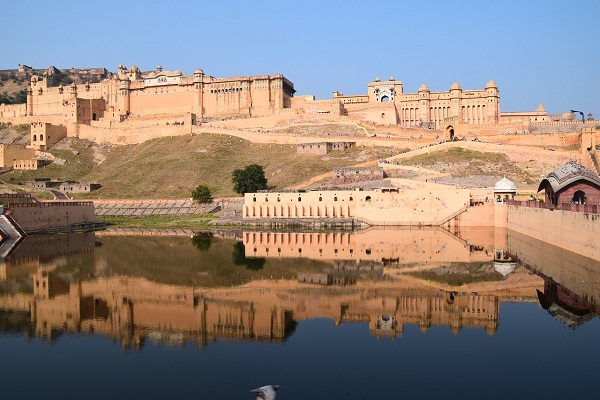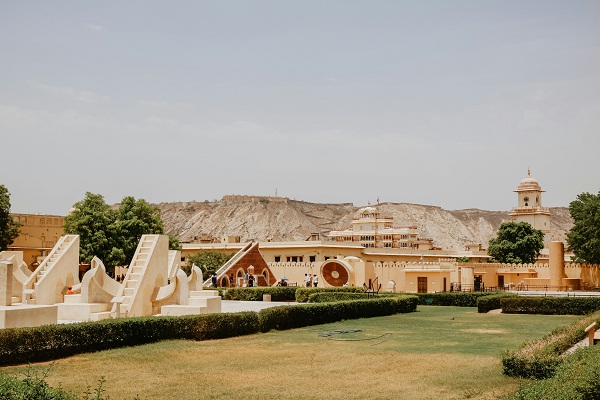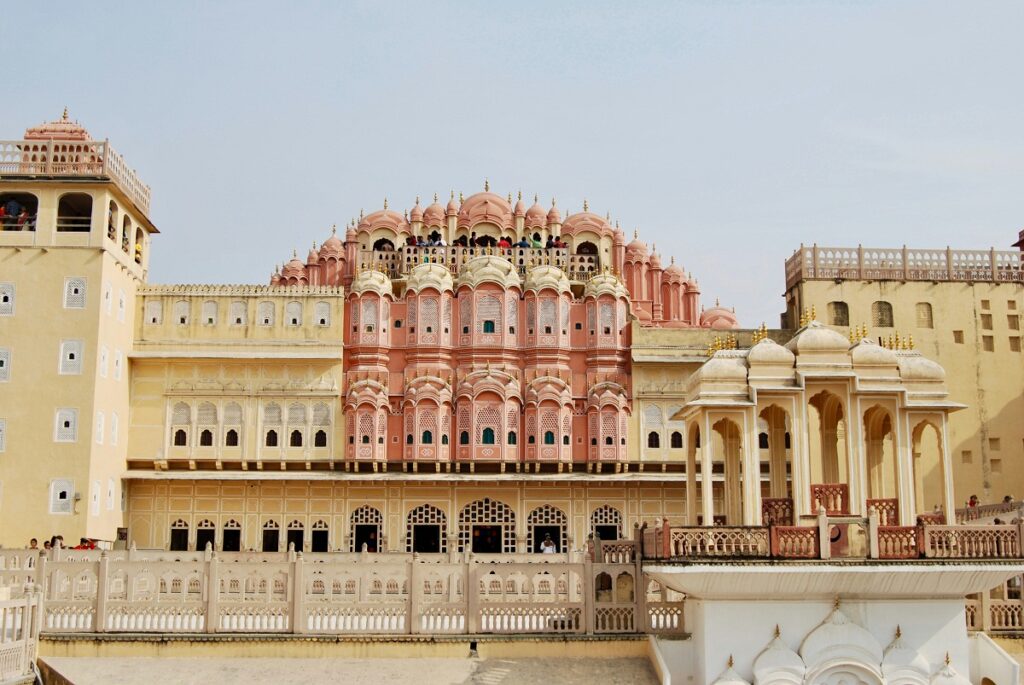Best Time to Visit Jaipur
Post Highlights
- 1 Introduction to Jaipur
- 2 Jaipur is Famous For
- 3 Best Places to Visit and Nearby Attractions in Jaipur
- 4 Itinerary to Visit Jaipur and Nearby Places
- 5 How to Reach Jaipur
- 6 Best Hotels in Jaipur
- 7 Best Time to Visit Jaipur
- 8 Local Culture & Cuisine of Jaipur
- 9 Activities to Do in Jaipur
- 10 Jaipur Travel Budget
- 11 Jaipur Reviews of Travelers
- 12 Traveling with Family or Solo
- 13 Travel Essentials
- 14 Important Instructions
- 15 Safety Travel Tips
- 16 Conclusion
Introduction to Jaipur
Jaipur, the capital of Rajasthan, is a city of enchanting history, vibrant culture, and architectural splendor. Founded in 1727 by Maharaja Jai Singh II, Jaipur is often referred to as the “Pink City” due to its distinct pink-colored buildings in the old city. This historical gem is renowned for its majestic forts, beautiful palaces, and rich traditions, making it a prime destination for travelers seeking an authentic Indian experience.
Jaipur is Famous For
Jaipur is celebrated for its stunning architecture, rich heritage, and lively markets. The city is a blend of historical charm and modern vibrancy, known for its:
- Architectural Marvels: The Amber Fort, City Palace, and Hawa Mahal are iconic structures showcasing Rajputana architecture.
- Vibrant Markets: The bustling bazaars of Jaipur, like Johari Bazaar and Bapu Bazaar, offer a range of traditional handicrafts, jewelry, and textiles.
- Cultural Festivals: Events like the Jaipur Literature Festival and the Teej Festival highlight the city’s rich cultural life.
- Royal Heritage: Jaipur’s heritage is evident in its numerous palaces and forts, which once housed the royal family of the region.
Best Places to Visit and Nearby Attractions in Jaipur
1. Amber Fort

- Distance from City Center: 11 km (7 miles)
- Description: Amber Fort, a stunning blend of Hindu and Mughal architecture, stands majestically on a hill overlooking the city. This grand fort features elaborate courtyards, ornate palaces, and picturesque views of the surrounding landscape. Highlights include the Sheesh Mahal (Mirror Palace) and the Diwan-e-Aam (Hall of Public Audience). Visitors can enjoy an elephant ride up to the fort or explore its labyrinthine corridors and beautifully decorated rooms.
Visit Nestled in the heart of Rajasthan: Jaisalmer
2. City Palace

- Distance from City Center: 2 km (1.2 miles)
- Description: The City Palace complex is a magnificent blend of courtyards, gardens, and palaces that reflects Jaipur’s royal heritage. It houses several museums displaying a rich collection of royal artifacts, including costumes, weaponry, and artwork. The palace’s intricate architecture and serene courtyards provide a fascinating glimpse into the opulent lifestyle of the Maharajas. Don’t miss the Chandra Mahal and the Mubarak Mahal, which are particularly noteworthy.
3. Hawa Mahal

- Distance from City Center: 1.5 km (0.9 miles)
- Description: The Hawa Mahal, or “Palace of Winds,” is an iconic pink sandstone structure famous for its unique facade of 953 small windows. Designed for the royal ladies to observe street life without being seen, this architectural marvel is a testament to the ingenuity of Rajput architecture. The building’s intricate latticework and vibrant colors make it a must-see, and the views from the upper floors offer a glimpse into Jaipur’s bustling streets.
Visit the Positano promises an unforgettable experience for those seeking a perfect blend of relaxation and adventure.
4. Jantar Mantar

- Distance from City Center: 2 km (1.2 miles)
- Description: Jantar Mantar is an astronomical observatory built in the 18th century, featuring a collection of impressive instruments designed to study celestial bodies. It includes the world’s largest stone sundial, the Samrat Yantra, and various other instruments for measuring time, altitude, and celestial positions. The observatory not only showcases the scientific advancements of its time but also offers a fascinating insight into ancient astronomical practices.
5. Nahargarh Fort

- Distance from City Center: 15 km (9 miles)
- Description: Perched on the Aravalli hills, Nahargarh Fort provides panoramic views of Jaipur and the surrounding landscape. Originally built as a retreat for the Maharaja, the fort is known for its beautiful architecture, including ornate rooms and expansive terraces. The fort’s sunset views are particularly breathtaking, making it a popular spot for both tourists and locals. The fort also has a charming café where visitors can relax and enjoy the scenery.
6. Jaigarh Fort
- Distance from City Center: 15 km (9 miles)
- Description: Jaigarh Fort, known for its strategic military importance, is situated on the same ridge as Amber Fort. It is renowned for housing the world’s largest cannon on wheels, the Jaivana, and for its impressive defensive architecture. The fort’s extensive walls, watchtowers, and military barracks reflect its role as a formidable stronghold. Visitors can explore the fort’s numerous rooms, including the armory and the palace, and enjoy stunning views of the surrounding countryside.
Lorem ipsum dolor sit amet, consectetur adipiscing elit. Ut elit tellus, luctus nec ullamcorper mattis, pulvinar dapibus leo.
Itinerary to Visit Jaipur and Nearby Places
Day 1: Exploring Jaipur’s Iconic Landmarks
- Morning: Begin your adventure with a visit to the majestic Amber Fort, a stunning example of Rajput architecture. Enjoy an elephant ride or a jeep safari to reach the fort, adding a touch of adventure to your experience. Take time to explore the fort’s impressive courtyards, palaces, and gardens.
- Afternoon: Head to the City Palace, a royal residence that offers a glimpse into Jaipur’s regal past. Don’t miss the Jantar Mantar, an astronomical observatory with impressive instruments that were used to study celestial bodies.
- Evening: Stroll around the vibrant markets near Hawa Mahal, also known as the Palace of Winds. Immerse yourself in the local culture, shop for traditional handicrafts, and savor a delightful dinner at a local restaurant, sampling authentic Rajasthani cuisine.
Day 2: Forts and Scenic Views
- Morning: Start your day with a visit to Nahargarh Fort, perched on the Aravalli hills. The fort offers panoramic views of the city and is a perfect spot for photography and relaxation.
- Afternoon: Explore Jaigarh Fort, known for its impressive ramparts and the world’s largest cannon on wheels. The fort provides fascinating insights into the military history of the region and offers splendid views of the surrounding landscape.
- Evening: Return to the city and unwind with a relaxing dinner at one of Jaipur’s renowned restaurants. Indulge in the local flavors and enjoy a leisurely evening.
Day 3: Museums and Nearby Towns
- Morning: Visit the Albert Hall Museum, which houses a rich collection of artifacts, including sculptures, paintings, and textiles. Continue your cultural exploration at the Birla Mandir, a beautiful temple dedicated to Lord Vishnu and Lakshmi.
- Afternoon: Take a short drive to Samode, a nearby town known for its traditional Rajasthani ambiance. Explore the local heritage, visit the Samode Palace, and experience the charm of rural Rajasthan.
- Evening: Return to Jaipur and use the remaining time to revisit any attractions you may have missed or indulge in some last-minute shopping at the local bazaars.
How to Reach Jaipur
- By Air: Jaipur International Airport (JAI) is well-connected to major cities across India and offers international flights as well.
- By Train: Jaipur Junction Railway Station is a significant rail hub with connections to major cities and towns throughout India.
- By Road: Jaipur is accessible via National Highways from cities such as Delhi, Agra, and Ahmedabad. The city is also well-served by regular bus services.
Best Hotels in Jaipur
- Rambagh Palace
- A luxurious heritage hotel renowned for its royal hospitality and opulent dining experiences. The palace offers an exquisite blend of traditional and modern comforts.
- The Oberoi Rajvilas
- Known for its exceptional service and beautiful gardens, this hotel features private villas and offers a serene and upscale experience.
- ITC Rajputana
- A sophisticated hotel combining modern amenities with traditional Rajasthani hospitality. It provides a comfortable stay with elegant decor and excellent facilities.
- Jaipur Marriott Hotel
- A contemporary hotel located in a central area, offering excellent facilities, spacious rooms, and a range of dining options.
- Alsisar Haveli
- A charming heritage hotel with traditional Rajasthani decor and warm service. The haveli provides a cozy, authentic experience with its classic ambiance and attentive hospitality.
Best Time to Visit Jaipur
Jaipur, the Pink City of India, is a magnificent destination known for its rich heritage, vibrant culture, and stunning architecture. To fully enjoy all that this historical city has to offer, the best time to visit is between October and March. During these months, Jaipur experiences its winter season, which brings cooler temperatures and more comfortable conditions for exploring the city’s many attractions.
October to March: This period is ideal for sightseeing as the weather is pleasantly cool and dry. Daytime temperatures range from 15°C to 25°C (59°F to 77°F), making it perfect for wandering through Jaipur’s palaces, forts, and markets. The pleasant climate also makes this time ideal for outdoor activities, such as camel rides, hot air ballooning, and attending local festivals. The months of December and January can be particularly charming with crisp air and clear skies.
April to June: The summer months in Jaipur can be quite challenging due to the extreme heat. Temperatures often soar above 40°C (104°F), which can make outdoor exploration uncomfortable and potentially hazardous. If you plan to visit during this time, be prepared for intense heat and stay hydrated. Early mornings and late evenings are the best times to venture outside, and indoor attractions like museums and palaces provide a welcome respite from the heat.
July to September: The monsoon season brings occasional rains to Jaipur, which can offer some relief from the intense summer heat. However, this period also comes with high humidity and sporadic downpours that might disrupt travel plans. The rain can enhance the beauty of the city’s landscapes, but it’s essential to be prepared for wet conditions and potential flooding in some areas. Despite the challenges, the monsoon season also contributes to the lush greenery around Jaipur, providing a different perspective on the city.
In summary, to make the most of your visit to Jaipur and enjoy a range of outdoor activities and historical sites comfortably, planning your trip between October and March is highly recommended.
Local Culture & Cuisine of Jaipur
Culture
Jaipur, often referred to as the “Pink City,” boasts a rich cultural heritage deeply embedded in its history and traditions. The city’s royal past is vividly reflected in its vibrant festivals, music, dance, and traditional crafts. Jaipur is renowned for its majestic forts, palaces, and intricate architectural styles that echo the grandeur of its regal history.
Festivals:
Jaipur is known for its lively festivals that bring the city to life with color and exuberance. Teej, celebrated during the monsoon season, is a festival dedicated to the goddess Parvati and is marked by elaborate processions, traditional dances, and colorful attire. Diwali, the festival of lights, transforms Jaipur with dazzling decorations, festive lamps, and a warm atmosphere of joy and unity. These festivals are an opportunity to witness traditional rituals and partake in local celebrations.
Music and Dance:
The traditional music and dance of Jaipur are integral to its cultural landscape. Folk music, often performed with instruments like the sarangi and dholak, accompanies lively dance forms such as Ghoomar and Kalbelia, which showcase intricate movements and vibrant costumes.
Crafts:
Jaipur is renowned for its artisanal crafts, including blue pottery, block printing, and minakari (enamel work). These crafts are not only a testament to the city’s artistic heritage but also offer a unique shopping experience for visitors.
Cuisine
Jaipur’s cuisine is a delightful reflection of Rajasthan’s culinary traditions, characterized by bold flavors and rich textures. The local food is often spicy and incorporates a variety of aromatic spices, making it a feast for the senses.
Dal Baati Churma:
This quintessential Rajasthani dish is a combination of three distinct components. Dal is a savory lentil curry cooked with spices, Baati are round wheat rolls that are typically baked until crisp, and Churma is a sweet, crumbly dessert made from crushed baati, ghee, and sugar. This dish offers a balanced blend of flavors and textures, showcasing the essence of Rajasthani cuisine.
Ghevar:
Ghevar is a traditional Rajasthani sweet, particularly popular during festivals such as Teej and Diwali. Made from flour, sugar, and ghee, this disc-shaped dessert has a honeycomb-like texture and is often garnished with nuts and saffron. Its unique preparation process and delicate sweetness make it a must-try treat.
Laal Maas:
For those who enjoy spicy food, Laal Maas is a must-try. This fiery mutton curry is known for its deep red color, which comes from an abundance of red chilies. The rich, spicy gravy is cooked slowly to tenderize the meat and infuse it with intense flavors. Laal Maas is typically enjoyed with traditional Indian bread or rice, adding a comforting element to its bold taste.
Exploring Jaipur offers a captivating glimpse into a culture that harmoniously blends historical grandeur with vibrant traditions, all while indulging in a rich and flavorful culinary experience.
Activities to Do in Jaipur
- Explore the Forts and Palaces: Jaipur, known as the “Pink City,” is famed for its magnificent forts and palaces. Begin your journey with the Amber Fort, a stunning example of Rajput architecture with its intricate mirror work and sprawling courtyards. Visit the City Palace, a splendid fusion of Rajasthani and Mughal styles, which also houses a museum showcasing royal artifacts. Don’t miss the Hawa Mahal, or Palace of Winds, an iconic structure with its unique façade and numerous windows designed for the royal women to observe street life without being seen.
- Shopping: Jaipur is a shopper’s paradise with vibrant markets brimming with traditional Rajasthani craftsmanship. Wander through the bustling streets of Johari Bazaar and Bapu Bazaar to find exquisite jewelry, colorful textiles, and handcrafted pottery. Explore the Tripolia Bazaar for its unique collection of brassware and Mirza Ismail Road for a variety of traditional garments and accessories. The local markets are perfect for picking up souvenirs that reflect Jaipur’s rich heritage.
- Cuisine Tour: Immerse yourself in the rich flavors of Rajasthani cuisine. Start with Dal Baati Churma, a traditional dish consisting of spicy lentils served with round wheat breads and a sweet, crumbled dessert. Try Ghewar, a honeycomb-like sweet treat, and Laal Maas, a fiery red meat curry. Enjoy a variety of street food such as Pyaaz Kachori and Samosas. For a more luxurious experience, dine at one of the heritage hotels offering royal Rajasthani thalis in an opulent setting.
- Cultural Experiences: Engage with the vibrant culture of Jaipur by attending one of its many local festivals, such as Jaipur Literature Festival or Teej Festival, which celebrate the city’s rich traditions. Experience traditional Rajasthani dance forms like Ghoomar and Kalbelia, and listen to local music performances that offer insight into the region’s artistic heritage. Visit Chokhi Dhani, a cultural village, to enjoy folk dances, puppet shows, and a traditional Rajasthani dinner in an authentic setting.
Jaipur Travel Budget
For a couple, the approximate travel budget is:
- Accommodation: $80 to $300 per night (depends on the type of hotel).
- Food: $20 to $50 per day.
- Transportation: $20 to $50 per day (local travel and taxis).
- Sightseeing: $10 to $30 per day (entry fees and guide charges).
Local Currency: The Indian Rupee (INR)
Estimated Budget in INR: 10,000 to 25,000 per day
Jaipur Reviews of Travelers
Positive Reviews:
- Many travelers praise Jaipur for its stunning architecture, friendly locals, and vibrant culture. The city’s rich history and beautiful landmarks are often highlighted.
Negative Reviews:
- Some travelers mention the city’s traffic congestion and the heat during summer months as potential drawbacks. Issues with cleanliness in some areas are also noted.
Traveling with Family or Solo
Jaipur is suitable for both family vacations and solo travel. Families can enjoy the historical sites, palaces, and cultural experiences, while solo travelers can explore the city’s rich heritage and vibrant markets at their own pace.
Travel Essentials
- Travel Essentials: Ensure you have your passport, visa (if necessary), and travel insurance.
- Clothing: Comfortable clothing, sun protection, and a light jacket for cooler evenings.
- Medication: Any personal medications and basic first aid supplies.
Important Instructions
- Respect local customs and dress modestly, especially when visiting religious sites.
- Stay hydrated and use sunscreen to protect against the sun.
- Carry a map or use a GPS app to navigate the city.
Safety Travel Tips
- Avoid traveling alone at night in unfamiliar areas.
- Use reputable taxi services or ride-sharing apps.
- Keep an eye on your belongings and avoid displaying valuable items in crowded places.
Conclusion
Jaipur, with its vibrant culture, majestic architecture, and rich history, offers an unforgettable travel experience. Whether you’re exploring its grand palaces, shopping in bustling markets, or savoring traditional Rajasthani cuisine, the Pink City has something for everyone. Plan your visit wisely, and you’ll be rewarded with an enriching and memorable journey through one of India’s most enchanting cities.



